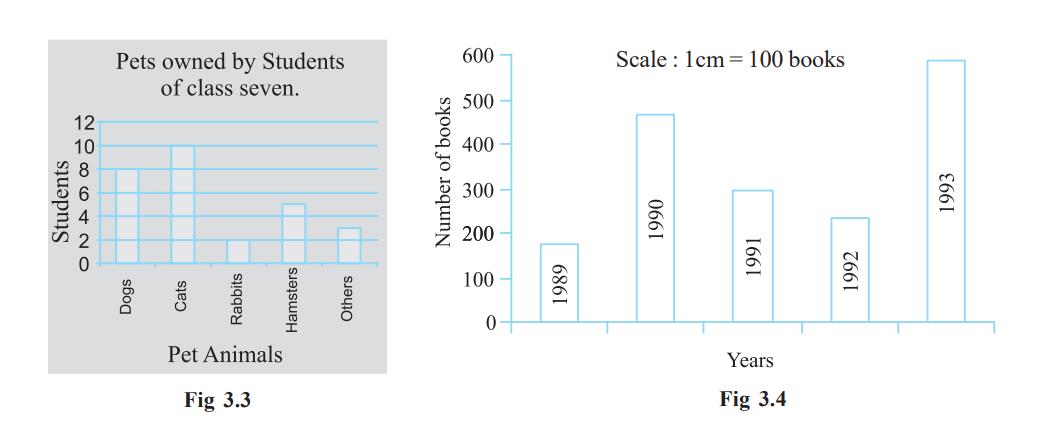Data Handling Chapter 3 Mathematics class 7th Solutions, Graphicla solutions for Exercise 3.3 Mathematics. Solutions for Exercise 3.3 of Mathematics Class 7th, NCERT Maths solutions for class 7th, Questions and Solutions for NCERT Class 7th Mathematics , Graphs for class 7 th Exercise 3.3, Questions and answers of NCERT class 7th Mathematics, detailed solution Notes for NCERT Class 7th Mathematics, Class 7th Maths solutions wikipedia, Solutions for class 7th NCERT Mathematics Class Seventh Maths Solutions with Questions, Solution for Class 7th Mathematics, Class 7th Maths solutions wikipedia, Class 7 th Chapter 3 Solutions for Mathematics.
Please find the detailed Solutions for class 7th Maths Chapter 3 -Data Handling Exercise 3.3 Solutions, you can check all the solutions from here chapter wise
NCERT Class 7th Mathematics Chapter 3 -Data Handling Exercise 3.3 Solutions
1. Use the bar graph (3.3) to answer the following questions.
(a) Which is the most popular pet? (b) How many children have dog as a pet?
Sol: (i) Cats. Because the bar representing cats is the tallest.
(ii) 8 children have dog as a pet.
2. Read the bar graph (Fig 3.4) and answer the questions that follow:
Number of books sold by a bookstore during five consecutive years.
(i) About how many books were sold in 1989? 1990? 1992?
Sol: In 1989, 175 books were sold. In 1990, 475 books were sold. In 1992, 225 books were sold.
(ii) In which year were about 475 books sold? About 225 books sold?
Sol: By studying the graph, it can be concluded that 475 books were sold in 1990 and 225 books were sold in 1992.
(iii) In which years were fewer than 250 books sold?
Sol: By studying the graph, it can be concluded that books in 1989 and 1992 were less than 250.
(iv) Can you explain how you would estimate the number of books sold in 1989?
Sol: From the scale given 1 cm = 100 books.
We can say that the books sold in 1989 were 1 cm and 3/4 part of next 1 cm.
1 cm = 100 books and 3/4 cm = (3/4) * 100 = 75 books.
So, total 100+75 = 175 books were so
3. Number of children in six different classes are given below. Represent the data on a
bar graph.
Class Fifth Sixth Seventh Eighth Ninth Tenth
Number of Children 135 120 95 100 90 80
Sol: The graph for the above data is given below
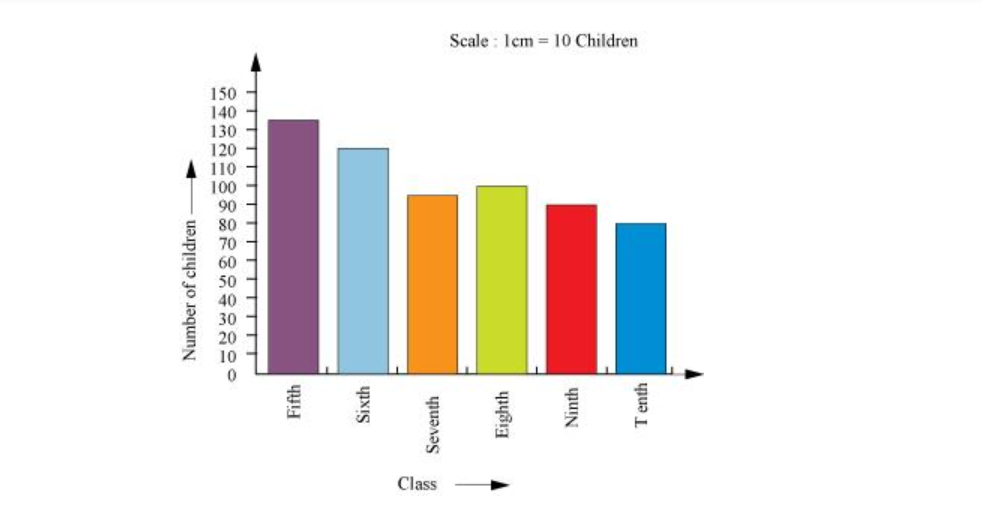
(a) How would you choose a scale.
Sol: Here the greatest value is 135 and the smallest value is 80 and there is minimum difference of 5 units. So we can select the end value greater than 135 such as 150. We will take 1 unit = 10 children by making equal divisions taking increments of 10.
(b) Answer the following questions:
(i) Which class has the maximum number of children? And the minimum?
Sol: Since the bar representing class Fifth is the tallest and the bar representing class Tenth is the shortest, so Class Fifth has the maximum number of children and Class tenth has minimum number of children.
(ii) Find the ratio of students of class sixth to the students of class eight.
Sol: Number of students in class sixth = 120
Number of students in class eight = 100
Ratio = 120 / 100
= 6/5
=6:5
4. The performance of students in 1st Term and 2nd Term is given. Draw a double bar
graph choosing appropriate scale and answer the following:
Subject English Hindi Maths Science S. Science
1st Term (M.M. 100) 67 72 88 81 73
2nd Term (M.M. 100) 70 65 95 85 75
Sol: The graph for above data is shown below
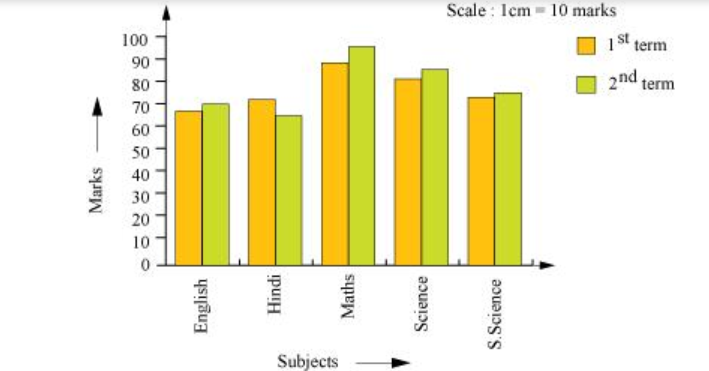
(i) In which subject, has the child improved his performance the most?
Ans: Maths. Because there was maximum increase in the marks in Maths.
(ii) In which subject is the improvement the least?
Ans: S. Science
(iii) Has the performance gone down in any subject?.
Ans: Hindi. Because there is decrease in marks in Hindi.
5. Consider this data collected from a survey of a colony.
Favourite Sport Cricket Basket Ball Swimming Hockey Athletics
Watching 1240 470 510 423 250
Participating 620 320 320 250 105
Sol: The graph of above data is given below
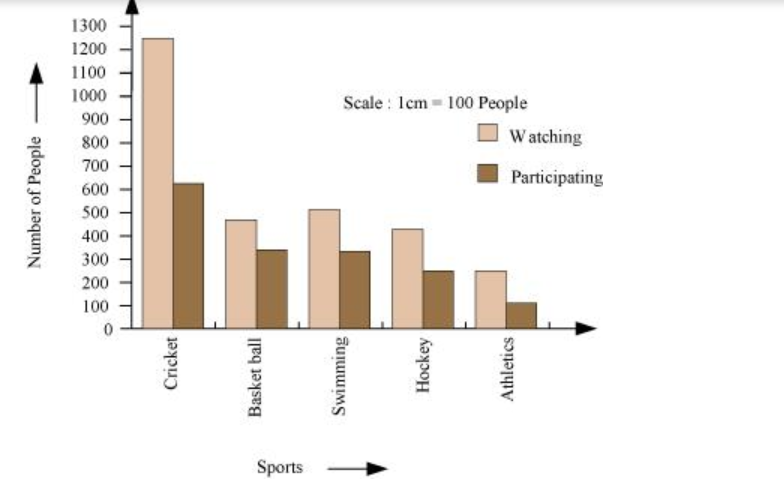
(i) Draw a double bar graph choosing an appropriate scale.
What do you infer from the bar graph?
Sol: From the graph it can be noted that Cricket is the most popular game.
(ii) Which sport is most popular?
Sol: Cricket. Because it can be seen from the graph that both bars of watching and participating in cricket are tallest among all.
(iii) Which is more preferred, watching or participating in sports?
Sol: Watching Sports. Because, in every sport, the bar representing watching is taller than the bar representing participating.
6. Take the data giving the minimum and the maximum temperature of various cities
given in the beginning of this chapter (Table 3.1). Plot a double bar graph using the
data and answer the following:
Sol: The graph for the above data is given below:
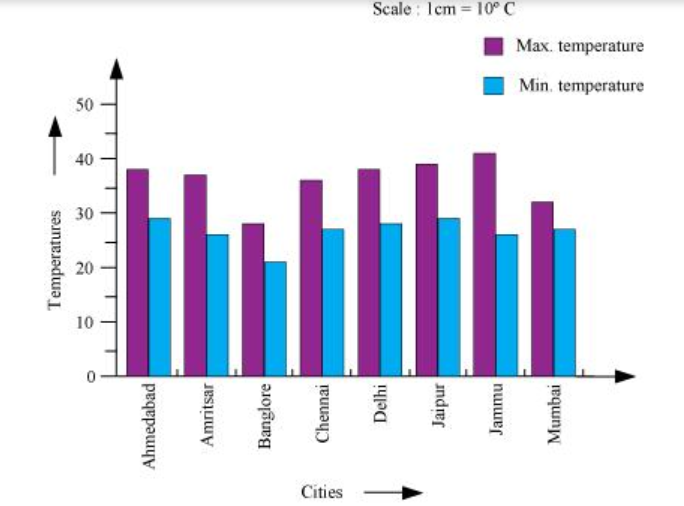
(i) Which city has the largest difference in the minimum and maximum temperature
on the given date?
Sol: Jammu. Because there is maximum difference between the bars representing maximum and minimum temperature.
(ii) Which is the hottest city and which is the coldest city?
Sol: Hottest city is Jammu and the coldest city is Bangalore.
(iii) Name two cities where maximum temperature of one was less than the minimum
temperature of the other.
Sol: Bangalore and Jaipur or Bangalore and Ahmedabad
For Bangalore the maximum temperature was 28 C while the minimum temperature of Jaipur and Ahmedabad was 29 C.
(iv) Name the city which has the least difference between its minimum and the
maximum temperature.
Sol: Mumbai has the least difference between its minimum and the
maximum temperature.
You can find the solutions for previous exercise from here
- Class 7th Maths – Exercise 3.2 Solutions
- Class 7th Maths – Exercise 3.1 Solutions
- Class 7th Maths – Exercise 2.7 Solutions
- Class 7th Maths – Exercise 2.6 Solutions
- Class 7th Maths – Exercise 2.5 Solutions
- Class 7th Maths – Exercise 2.4 Solutions
- Class 7th Maths – Exercise 2.3 Solutions
- Class 7th Maths – Exercise 2.2 Solutions
- Class 7th Maths – Exercise 2.1 Solutions
- Class 7th Maths – Exercise 1.4 Solutions
- Class 7th Maths – Exercise 1.3 Solutions
